Craving a healthier spin on traditional Beetroot Paneer Paratha? This version brings a nutritious and colorful upgrade to your plate. Try this vibrant Beetroot Paneer Paratha! With beetroot lending its vibrant color and subtle sweetness, this dish stands out for both its visual appeal and delicious taste.
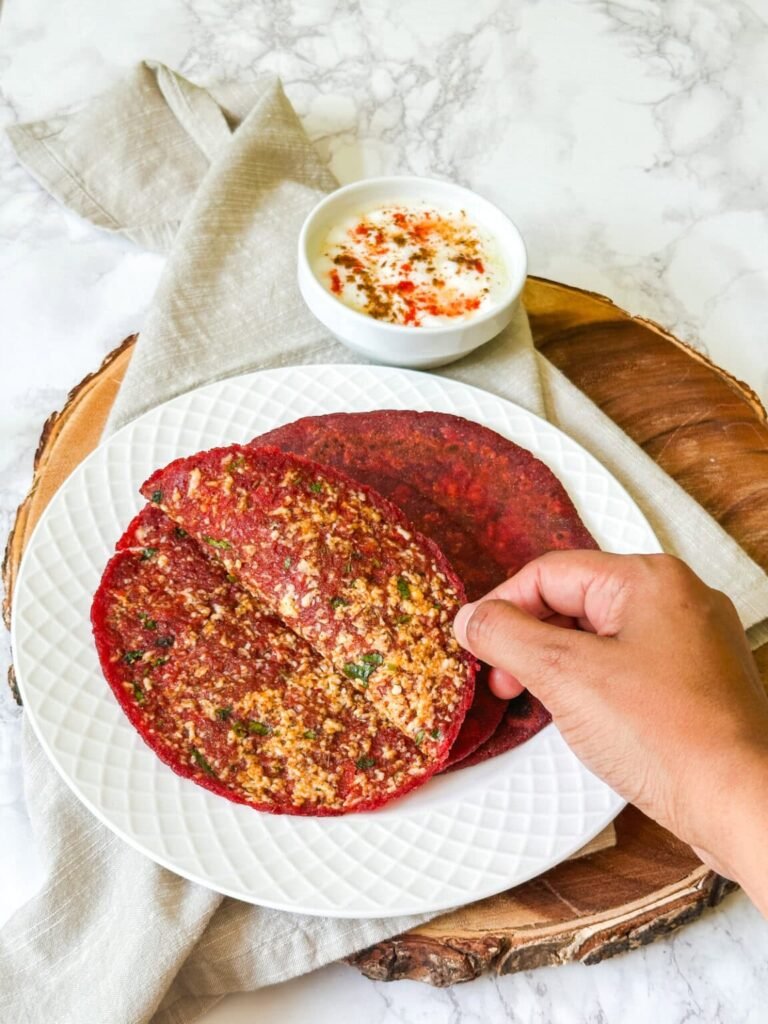
Beetroot-ginger purée gives the dough a vibrant hue, subtle earthy flavor, and a mild, warming kick. A splash of lemon juice adds a refreshing tang, cutting through the beetroot’s natural sweetness for a well-rounded flavor.
Inside, the no-cook paneer filling is quick to prepare and full of bold Indian spices. Crumbled paneer combines with amchur, chaat masala, chili powder, and herbs for a mildly spiced, flavorful, and aromatic stuffing.
These Beetroot Paneer Paratha are:
Wholesome and satisfying – Ideal for lunchboxes, brunch, or a hearty breakfast.
Kid-friendly – Soft in texture with balanced flavors that aren’t overly spicy.
Beautifully colored – Naturally dyed with beetroot, making them an appealing option for picky eaters.
Serve hot with chutney or pickle—an easy, vibrant way to enjoy more veggies and paneer in a delicious stuffed paratha.
Ingredient Notes For Beetroot Paneer Paratha:
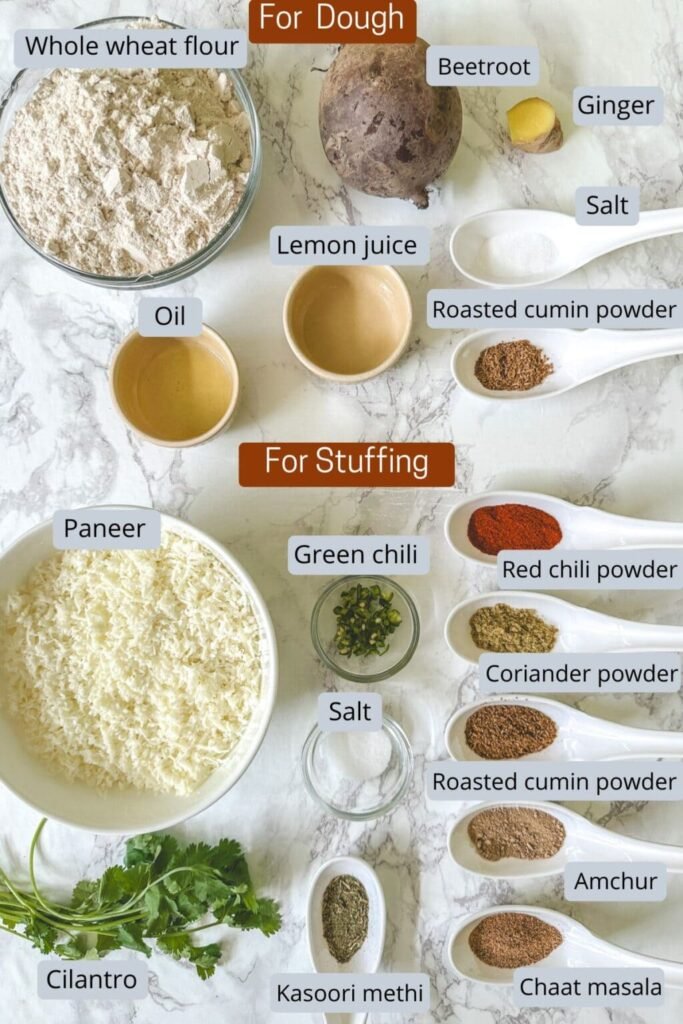
For Dough:
- Beetroot Purée: To give the paratha its vibrant reddish-pink color and subtle earthy sweetness, we use a homemade beetroot purée as the liquid base for kneading the dough. This purée is prepared by blending raw beetroot with a small piece of fresh ginger, a dash of lemon juice, and just enough water to help it blend smoothly. The ginger adds a mild zing, while the lemon juice provides a slight tang to balance the natural sweetness of the beetroot. This not only enhances the taste but also ensures the dough remains soft and pliable.
For The Stuffing:
- Paneer (Indian Cottage Cheese): Soft, crumbled paneer serves as the core of the stuffing, offering a deliciously rich texture and a good dose of protein. Store-bought paneer works well, but homemade offers a softer, richer texture. Ensure it isn’t too moist—lightly squeeze if needed—to avoid soggy parathas.
- Spice Powders: Classic Indian spices bring the paneer to life. Amchur brings a sharp tanginess, chaat masala adds a burst of savory flavor, red chili powder delivers mild heat, and turmeric infuses a golden hue with subtle earthiness. These create a flavorful but balanced filling.
- Salt: Add salt with caution. Since chaat masala already contains salt, it’s best to taste the mixture first to avoid over-seasoning.
- Kasoori Methi: Crushed dried fenugreek leaves infuse the stuffing with a distinctive, slightly bitter aroma that pairs wonderfully with the richness of the paneer.
- Roasted Cumin Powder: For homemade cumin powder, gently toast cumin seeds over low heat until they turn golden and release a rich, nutty aroma. Cool and grind into a coarse powder. It adds a smoky, earthy flavor to the mix.
- Green Chili (Optional): Finely chopped green chilies offer heat for those who like it spicy. Skip or reduce for a kid-friendly version.
- Fresh Cilantro: Chopped coriander leaves bring a fresh, herby brightness that lifts the overall flavor and adds a burst of color.
Step-by-Step Instruction To Make Beetroot Paneer Paratha With Tips:
1) Prepare the Beetroot Purée
Start by peeling and chopping the raw beetroot into small cubes. Transfer the beetroot pieces to a blender jar along with a small piece of fresh ginger and a splash of lemon juice. Add just enough water to help with blending and grind everything into a silky-smooth purée. This vibrant beetroot mixture not only lends color but also infuses the dough with mild earthy-sweetness and a hint of zing from the ginger and lemon.

2) Knead the Dough
Note: These instructions use a stand mixer for ease, but you can knead the dough by hand using the same steps.
In a large mixing bowl (or the bowl of your stand mixer), combine whole wheat flour, salt, and a bit of homemade roasted cumin powder. Add a tablespoon of oil or ghee for softness. Add the prepared beetroot purée and start kneading. If using a stand mixer, start on low speed with the dough hook attachment, then gradually increase to medium until the dough forms a soft, smooth ball. Scrape down the sides if necessary.
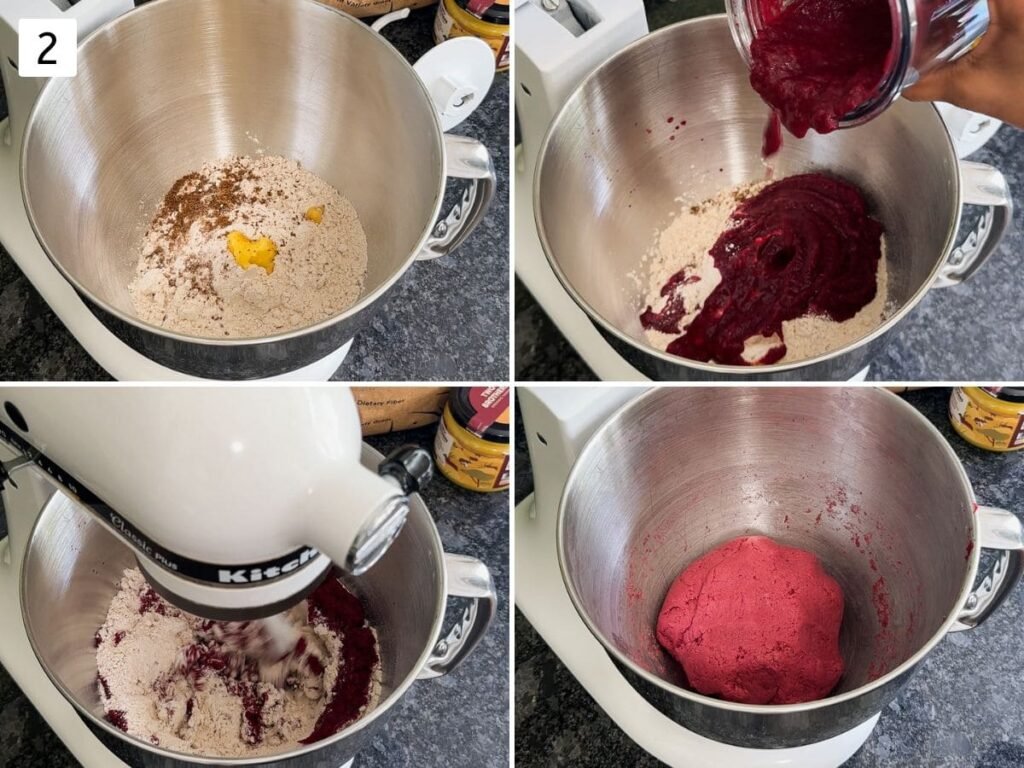
Let the dough rest, covered, for 10–15 minutes. A well-kneaded dough should be soft and pliable—neither too stiff nor sticky. If the dough feels hard, add a splash of water. If it’s overly sticky, sprinkle in a little extra flour.
3) Prepare the Paneer Stuffing
While the dough rests, make the stuffing. In a mixing bowl, combine crumbled paneer, chopped green chilies (optional), finely chopped fresh cilantro, salt, and the spice powders—such as amchur, red chili powder, chaat masala, turmeric, and roasted cumin powder. Mix everything thoroughly using a spoon or your hands until evenly combined. Set aside.
Pro Tip: If the paneer feels too crumbly or dry, you can add a tiny bit of milk or cream to moisten the mixture slightly.

4) Divide the Dough
Once the dough has rested, knead it briefly again to make it smoother. Then divide it into 10 equal-sized portions. Roll each portion between your palms to form smooth balls, then flatten them slightly into discs.
Tip: Lightly grease your palms with a few drops of oil while rolling to prevent the dough from sticking.

5) Assemble and Roll the Parathas
Take one disc of dough and dust it lightly on both sides with dry flour. Roll it out into a small 5-inch round using a rolling pin—place 2 to 3 tablespoons of the paneer stuffing in the center.
Bring the edges of the dough together and pinch at the top to seal the stuffing inside, just like making a dumpling. Gently flatten the filled ball, dust again with dry flour, and begin rolling it out slowly into a 7–8-inch paratha. Use gentle pressure and roll from the center outward, turning as needed. Dust with flour if it sticks.
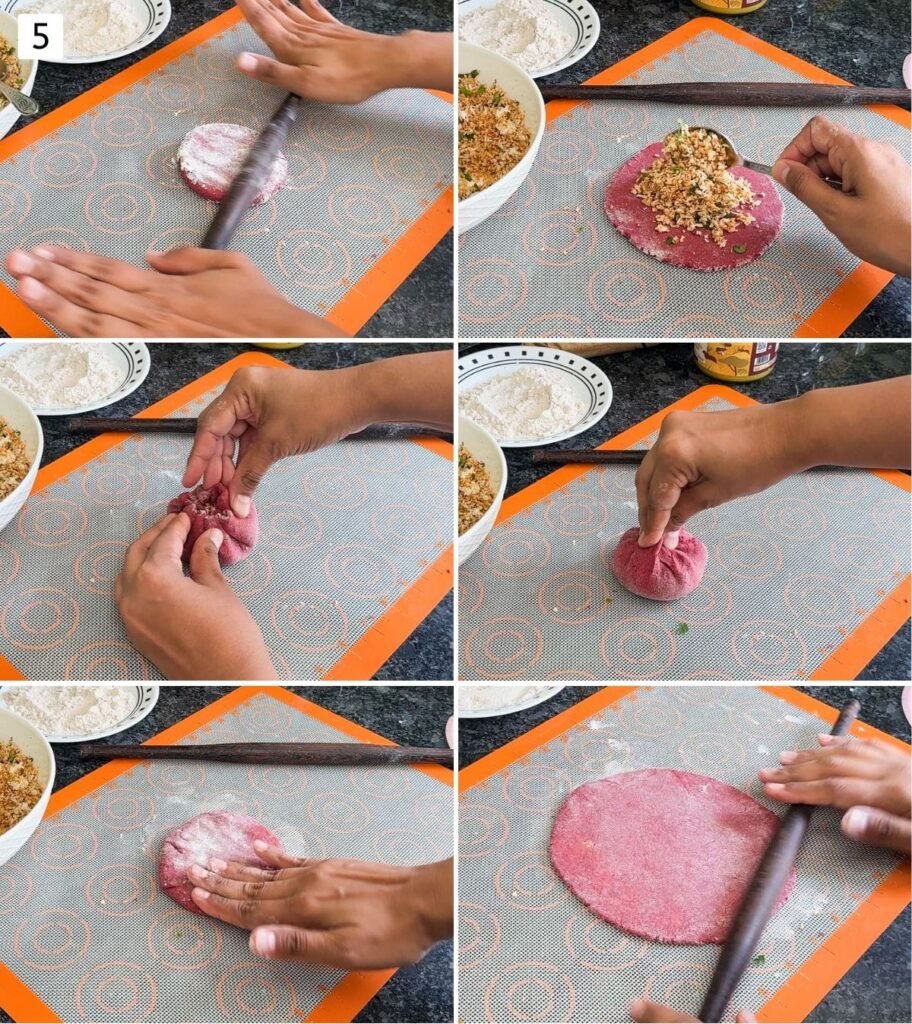
Important: Be sure to seal the edges tightly and avoid air pockets inside, as they can cause the paratha to tear while rolling.
6) Cook the Parathas
Preheat a tawa or flat skillet on medium heat. Once hot, place the rolled paratha on it. Cook for 30–40 seconds or until small bubbles appear on the surface, then flip it over.
Brush the cooked side lightly with oil or ghee, then flip again and do the same on the other side. Press gently with a spatula and continue cooking until both sides are golden with crisp brown spots.
Repeat with the remaining dough balls and stuffing.

Expert Tips for Perfect Beetroot Paneer Parathas:
- Use Fresh Beetroot: Always use fresh, firm beetroot for the purée. Overly mature beetroot can have a strong, earthy flavor and may lack the vibrant pink-red color desired for the dough.
- Don’t Overwater the Dough: Add beetroot purée slowly while kneading the dough. Aim for a soft and pliable dough—excess water can make it sticky and difficult to handle, while too little can result in a stiff, dry texture.
- Resting Time Matters: Allow the dough to relax for 10 to 15 minutes after kneading to help improve its texture and make it easier to roll. This helps gluten develop, making the dough easier to roll and improving the final texture of the paratha.
- Avoid Overstuffing: It might be tempting to add a generous amount of filling, but overstuffing makes the paratha difficult to seal and prone to tearing while rolling. A modest amount—about 2 to 3 tablespoons—is ideal.
- Even Rolling Technique: When rolling the Beetroot Paneer Paratha, apply gentle, even pressure and rotate the dough gradually to maintain a circular shape. Dust with flour only as needed to prevent sticking.
- Preheat the Tawa: A properly heated skillet is crucial for well-cooked, golden parathas. If the tawa isn’t hot enough, the paratha may turn dry and undercooked; if it’s overheated, the exterior might brown too fast while the inside remains raw.
Serving Suggestions For Beetroot Paneer Paratha:
These colorful Beetroot Paneer Paratha are a complete meal on their own, but pair beautifully with sides that enhance their flavors:
- Plain or Flavored Yogurt: A bowl of thick curd or raita (such as cucumber, boondi, or mint) complements the spices in the filling and cools the palate.
- Indian Pickles (Achaar): A tangy mango or lime pickle adds a spicy, sour contrast that lifts every bite.
- Butter or Ghee: A pat of butter or a drizzle of ghee on hot parathas takes them to the next level.
- Chutneys: Serve with green coriander-mint chutney or tangy tamarind chutney for extra flavor.
- Masala Chai or Lassi: For a North Indian breakfast or brunch feel, pair your paratha with a cup of spiced chai or a glass of sweet or salted lassi.
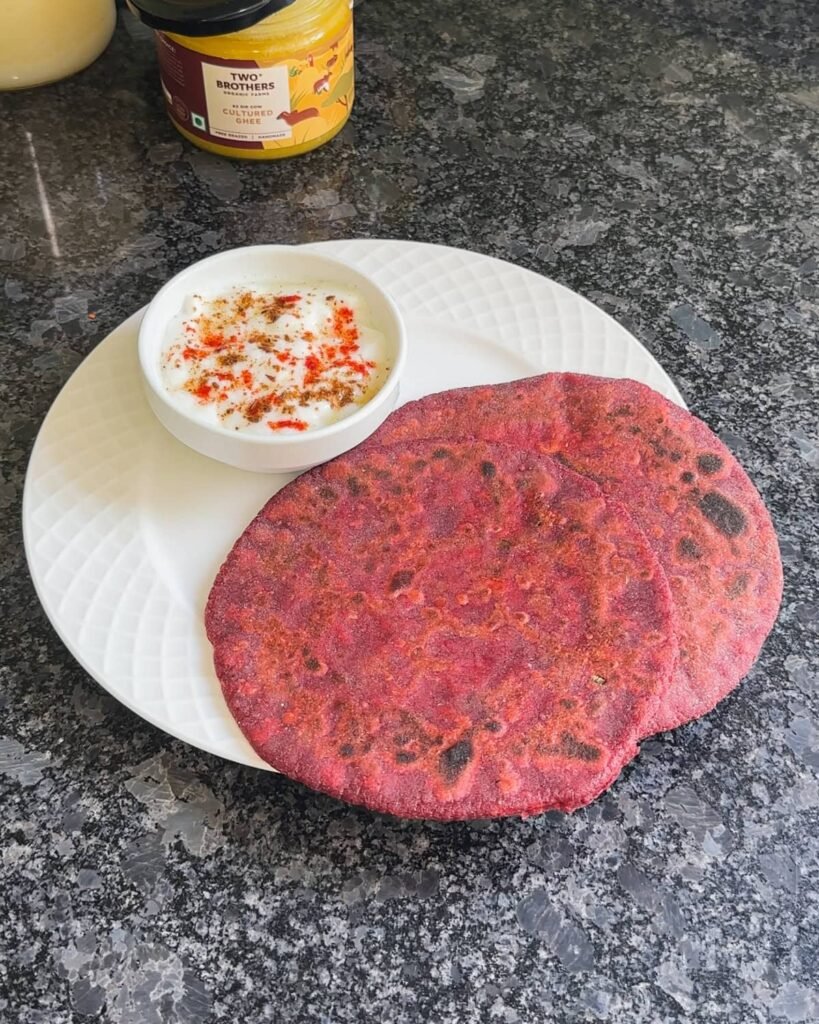
Variations You Can Try:
- Add Grated Veggies: Mix in grated carrot or cooked green peas to the paneer for extra nutrition and texture.
- Use Tofu Instead of Paneer: For a vegan version, replace paneer with crumbled tofu and use oil instead of ghee.
- Spicy Version: Add crushed garlic and extra green chili for a spicier filling.
- Cheese-Lover’s Paratha: Add some grated mozzarella or cheddar to the paneer for a fusion version kids will love.
